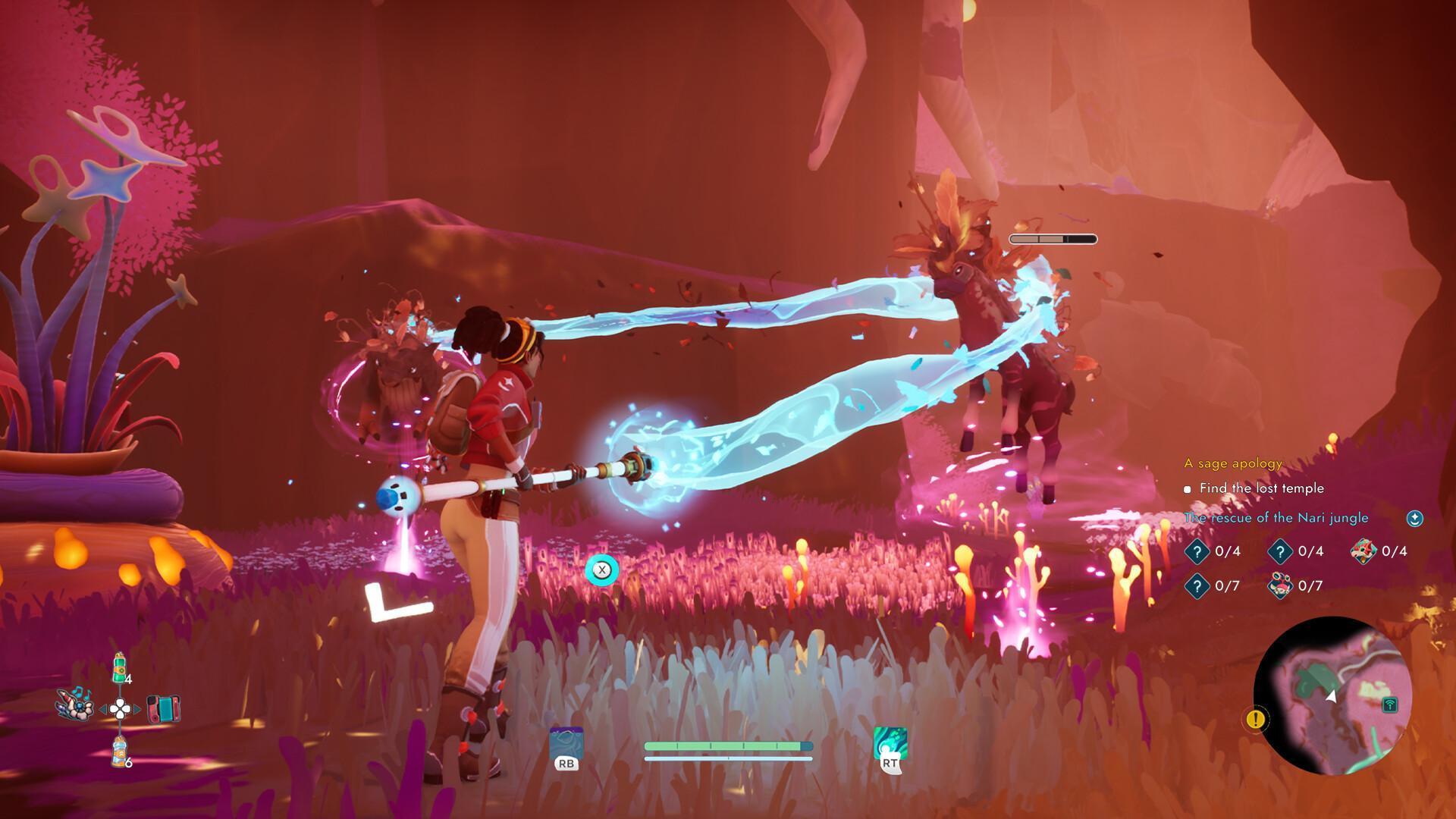
Creatures of Ava (XS) - Review
by Lee Mehr , posted on 08 September 2024 / 1,984 ViewsEarlier this year, an early access indie game called Palworld set the world on fire by parodying Pokémon to the nth degree. "You know how you capture pets to fight for you? Well, what if you could also use one as a meat shield under machine gun fire?" The plethora of certifiably insane & creative ideas in its first trailer alone sold this hook. Sharing similar space with the recently-released Flock, Creatures of Ava captures an inverse approach to that template: animal conservation. With an alien planet facing ecological calamity – making nods to our own predicament – Inverge Studios' creature collect-a-thon seems like the best solution.
Young conservationist Vic (Victoria Hamilton) is tasked by her company, Aleph, to save a set minimum of each species she can find. Given the expansive reach of the planet's disease, known as "the withering," she and tech assistant Tabitha are running on borrowed time. After crash-landing on Ava's surface, Vic subsequently stumbles upon some mysterious ruins and is greeted by a Yeti-like creature named Nim'ar. Rummaging through this ancient vault leads to her disinterring a magical staff that can cleanse parts of the environment and animals of the withering's infection. Serving as both a key to her conservationist efforts and a potential last-ditch effort to heal the planet, she sets off to rescue whoever she can.
The formula follows a rudimentary mix of Pokémon Snap and "cleaning-platformers" like The Gunk. You're able to snap photos of the flora and fauna at any time, which helps in cataloguing the various animals and important Naam across Ava. Given the fungus-riddled animals' newfound violent nature, combat against them is rather simple: fire the staff's energy burst at an infected and keep the energy beam's hold until they're renewed once again. Since most animals roam in a small pack, other infected who aren't initially targeted can be daisy-chained if they pass through the energy beam. There's a breezy rhythm to strafing and/or jumping past their attacks while stripping the disease off their bodies.
Although initially reticent to Vic's (and Aleph's) conservation plans, a Naam chieftain eventually shares how music coaxes them into following you. With a space flute and knowledge of that specific zone's special musical tune, you essentially turn into The Pied Piper: beat a quick rhythm-matching game to make that particular species follow you to a retrieval drone who'll subsequently teleport them to The BioArk. So long as you hold a tune, any charmed animal is at your beck and call. It goes beyond following in lock-step too, as charmed animals can essentially be "possessed" and carry a unique ability/abilities to expand exploration, like cutting ropes to drop bridges, ramming through vine blockades, pushing stone blocks, and so on and so on.
Both of these tenets work on paper, but don't quite measure up in execution. Vic's Pied Piper routine thematically complements the story and the world-building in some surprising ways. The learned songs from each of the four main biomes don't only act as mellifluous lures for the animals, but also manifest a sort of physical connection with them through Ava; it's essentially like the Na'vi (blue aliens) in Avatar but through harmonic resonance instead of a braided tentacle. Mechanically, though, there's not much to it past one-note animal interactions like breaking a highlighted wall or other videogame-y tropes. Imagine if there'd been more interactive elements, like creating new pathways through unique means or even comedic bits like knocking Vic on her ass with the very animal you're controlling. It's easy to tell they ran out of surface-level ideas when certain animals unique to each biome perform the same tasks in the same way.
At least there's some ephemeral fun in petting and controlling each animal. Combat on the other hand can be whittled down to aiming the staff in the right direction and sucking their infection bar down to zero. One primary issue is that it feels too static and flimsy. There's no pizzazz or a sense of genuine struggle compared to something like the Luigi's Mansion titles – yes, keeping in mind the different budgets too. Even on Hard difficulty (my choice), most infected enemies barely pack a punch and it's easy to kite around them before their AI-brain winds up the next attack. There are a few spots where environmental hazards add a decent challenge and some moments where staff abilities are useful, but not nearly enough, simply because basic attacks work well on their own.
Fortunately, staff upgrades fare better for exploration. Sticking close to its action-adventure inspirations, each of the four main biomes house unique ruins of a long-dead civilization. They act as both a means to acquire a new ability (like levitating certain objects) and reveal more world-building for Vic and Nim'ar, piecing together a possible way to restore the planet. A tried and true formula, sure, but Inverge's level design follows rewarding exploration rules: the subdued Metroidvania trappings, good use of verticality, and varied locales. My main level design gripe is how two areas (forest & swamp) have their point of no return at the end of their respective chapters instead of near the campaign's finale. There's a contextual reason why this is, but it feels like a cheap way to avoid reworking the map to show the withering's growing corruption, as seen in the main hub.
The bigger issue with Ava's gameplay stems from exploration being excited to be here while everything else is just here. Along with the amalgamation of creature collection, snapshots, platforming, and exploration, there's also crafting and an upgrade tree. Those features are fine, but they ought to feel like intentional complements to the larger whole. Here: it's just checklist game design. There's no harm in buffing Vic if you have herbs or talent points to spend, but most feel unnecessary when there's hardly any challenge to start with. I'm improving Vic's staff's cleansing power for no other reason than to speed up the same goddamn routine! It's hard to miss the irony of it all: your first unguided interactions with this foreign, luxuriant planet teeming with raw wildlife quickly become tamed by pre-packaged mechanics and Diet Ubisoft design quirks.
By contrast, Ava's story – mostly – works by virtue of its simplicity. I'll be the first to say there's a creativity gap between Rhianna Pratchett and her venerated father, but credit where it's due to her and this narrative design team. Rather than the painfully overwrought torture porn smeared across the Tomb Raider reboot, Vic's protective nature and hard-headedness is demonstrated through one emotional scene at the start and then subtly reinforced through gameplay and subsequent story beats. While too limited for their own good, Vic, Nam'ir, and Tabitha's character dynamics work and the supporting cast of haughty leaders and serene shepherds adds just enough flavor. You can see most "surprises" coming a mile away, but your actions to get there still carried weight.
It's a shame then that it's saddled with inconsistent presentation. I'm not talking about the pleasant soundtrack or the world design, mind you. Minus the elongated bean-shaped Naam, everything from the colors to the creatures looks as if Lisa Frank was on acid while constructing a sci-fi world (which I say with the highest respect); Carolina Ibáñez de Aldecoa's artstyle does awkwardly bump up against the Fortnite-esque look, given the game engine, but enough work is done to capture its own identity. The inconsistency I'm referring to is its schizophrenic approach to dialogue: segueing between voiced cutscenes, voiced in-game scenes, and voice-less text boxes without much indication. Were the voice actors only scheduled for limited days? Were there major draft re-writes towards the end of development? Either way, Vic's Rivka Rothstein deserved more quality airtime. 
Given this peculiar inconsistency, one can't help but interrogate Inverge's anxious need to be so expansive. The golden path lasting 8-9 hours, roughly 18 if going for a completionist run, isn't absurd number-crunching value at $25. That's not the point. The issue is this: what's compelling someone to play through that time? Pretty as it is, the world can't help but fade into the background in service of the collect-a-thon. This is only exacerbated if trying to 100% it because each animal's ability has to be used a select number of times and a huge amount have to be captured. The lower requirements for advancing the campaign make sense contextually, but the higher threshold to complete Vic's animal encyclopedia is a ridiculous slog.
Almost everyone can comprehend when someone states how a concept or idea feels underdeveloped; overdeveloped, however, is a tougher quality to discern. Creatures of Ava serves as a useful illustration of that. What begins as a breezy jaunt through an alien world becomes a creature-collector where you don't so much remember said creatures but rather their designed utility. Through both its modernized fixations and fetch-quest design, the once-brimming potential becomes inundated by unadventurous templates. That doesn't altogether discount Inverge's sincerity for this subject matter, nor how most mechanics at least function, but it's telling how saving animals felt less like conservation and more like homework over time.
Contractor by trade and writer by hobby, Lee's obnoxious criticisms have found a way to be featured across several gaming sites: N4G, VGChartz, Gaming Nexus, DarkStation, and TechRaptor! He started gaming in the mid-90s and has had the privilege in playing many games across a plethora of platforms. Reader warning: each click given to his articles only helps to inflate his Texas-sized ego. Proceed with caution.
VGChartz Verdict
6
Decent
This review is based on a digital copy of Creatures of Ava for the XS




























 Essay Pro
Essay Pro